From Abraham Lincoln to Albert Einstein – many of the world’s thought leaders were avid readers.
Most people only read about four books a year.
Including heavy readers, this average jumps to twelve books a year.
Today, GPT-3 and AI has read more books than you or any thought leader ever will. 🤯 Billions of words and articles across the web are tucked away in AI’s ever-expanding database. Engineers trained GPT-3 technology on Wikipedia, Common Crawl, WebText2, Books1, and Books2.
For some comparison here, Wikipedia alone has over six million articles alone.
How does GPT-3 technology use these incredible masses of data?
Well, AI text generators like our HyperWrite tool are now in existence to help writers create content faster and easier.
A GPT-3 article writer is complex enough to form human-like sentences but simple enough for you and me to use every day without training.

Where Does GPT-3 Technology Come From?
GPT-3 stands for Generative Pre-trained Transformer 3. It’s a text generator that uses statistics to make human-like text predictions.
GPT-3 technology was developed by OpenAI using Natural Language Processing systems. OpenAI is an artificial intelligence research company based out of San Francisco, California.
OpenAI first developed generative pre-training (GPT) in June 2018. GPT-3 is the third generation of the GPT model. It’s different from its predecessor GPT-2 in three main ways:
- GPT-3 has 175 billion parameters versus the much smaller GPT-2
- GPT-3 trained on 450 gigabytes of text – over ten times more text than GPT-2
- GPT-3 has 96 layers
- Wording embeddings in GPT-3 increased from 1600 to 12888
These advances made GPT-3 the most advanced language processing system available today.
How Do Businesses Use GPT-3 Technology?
Many businesses use GPT-3 to automate customer service. They want to replace human representatives that spend hours answering mundane questions with advanced AI that sound human-like. The actual humans will then be able to focus on more complex inquiries.
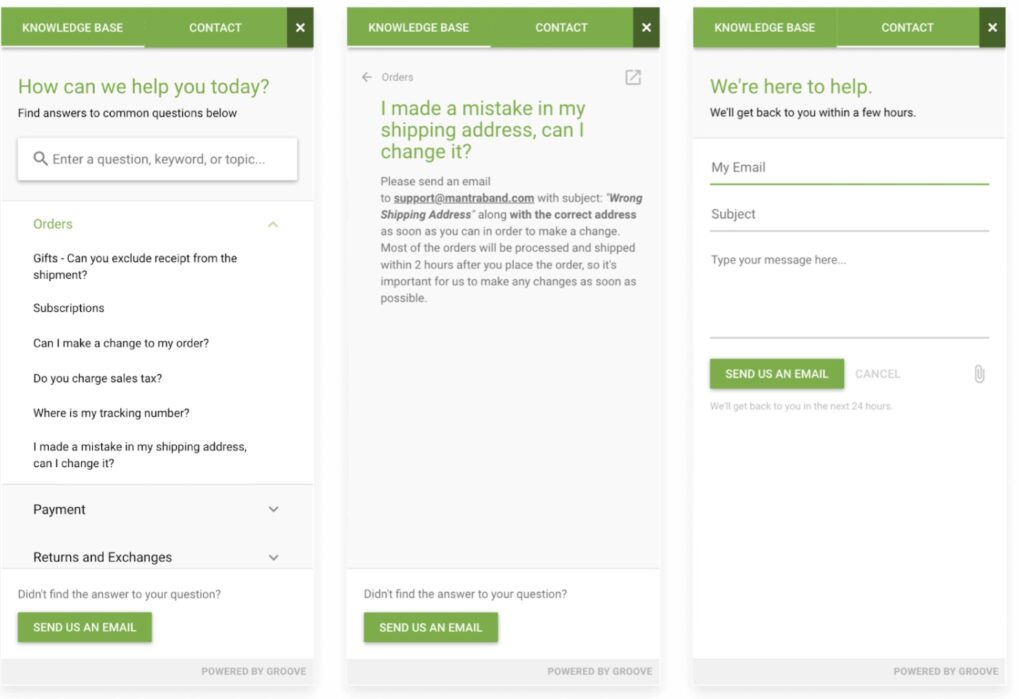
Screenshot from the Groove Blog
GPT-3’s ability to sound human-like has crossed over from customer service responses to crafting original content. When websites began claiming a GPT-3 writing generator was writing their content for them – writers grew nervous. Is AI at the point of replacing writers?
Think about other technology.
Did calculators replace mathematicians?
Did the Kitchen Aid replace chefs?
No, those tools are only assistants for humans.
GPT-3 is another tool to help streamline the writing process. It cuts down on some of the more mundane tasks like brainstorming and overcoming writer’s block, so that writers can focus on the complexities of content creation.
Later we will explore in more detail just how GPT-3 article writers do this by creating an article through our tool HyperWrite.
What Role Do Humans Play in GPT-3 Article Writer?
While GPT-3 text generators are more advanced than anything we’ve seen so far, human involvement is still necessary. Here are three ways humans work alongside GPT-3.
Humans Understand Semantics. GPT-3 text generations usually sound human-like. But every now and then a generation may not be as accurate as a person because it uses algorithms for text generation rather than semantic knowledge of underlying meanings. However, GPT-3 will become more accurate the more you write with it because it learns from you.
Humans Add Authentic Emotion. Emotion connects the reader to the content they’re reading. Because GPT-3 is a machine, it can only mimic human emotion. Much of GPT-3’s replicated emotion feels authentic, but humans can add another level of authenticity by infusing personal feelings into the piece.
Humans Create New Ideas. GPT-3 pulls from a nearly limitless database when generating ideas. They can then compile those ideas into unique text with creative twists. But humans don’t need previous knowledge to create. Instead, people can think outside of previous patterns to create brand new ideas.
The 5 Factors Your GPT-3 Article Writer Should Have
If you want to invest in a GPT-3 application for your team, consider these five factors that every GPT-3 article writer should have.
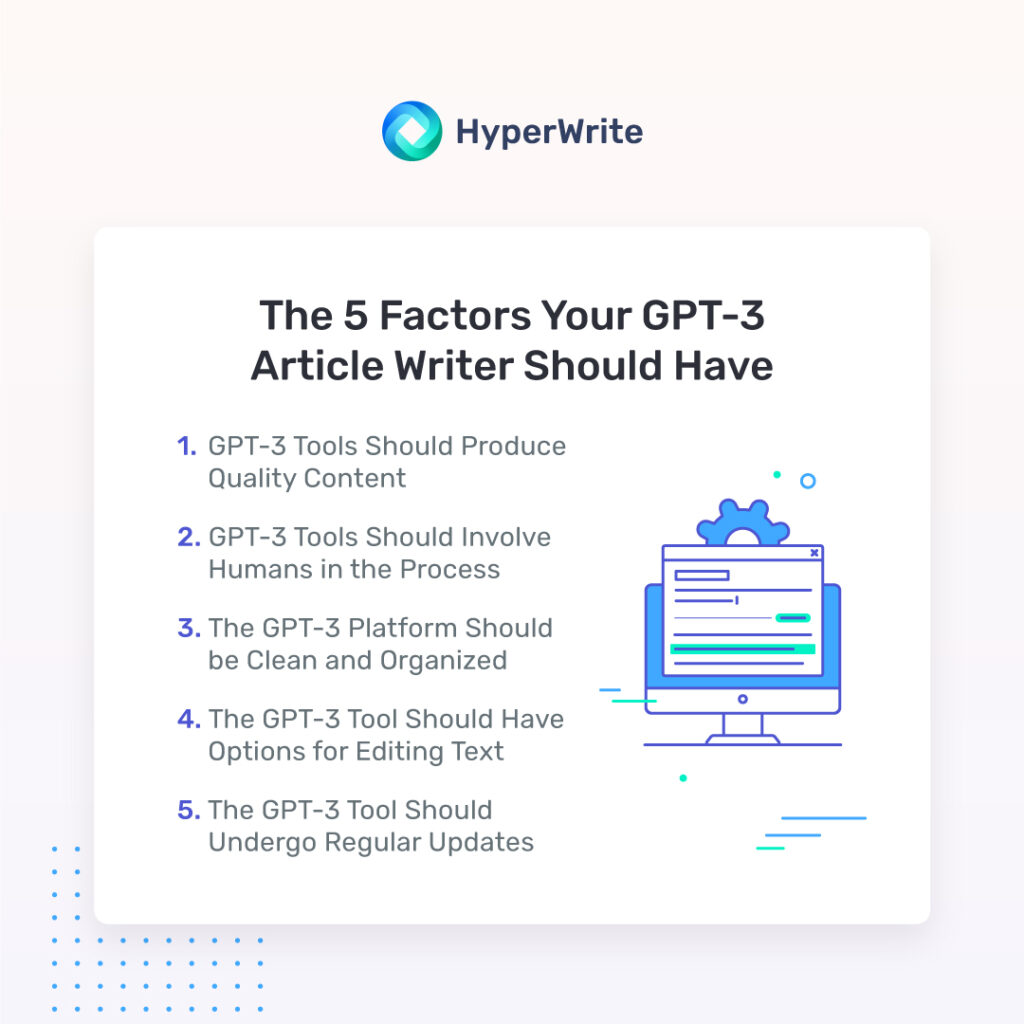
1. GPT-3 Tools Should Produce Quality Content
Don’t invest in a tool that copies content. Invest in a GPT-3 article writing tool that writes original, quality content.
What makes GPT-3 so advanced is the way in which it can take content from other sources, then craft it into something entirely unique. Other word predictors simply repeat the exact phrase or words others use – they don’t know how to rearrange thoughts.
2. GPT-3 Tools Should Involve Humans in the Process
Humans need to be involved in content creation – even with advanced technology like GPT-3 helping. Earlier we discussed some ways humans work with GPT-3.
If a GPT-3 tool claims to write articles for you, don’t trust it. The technology simply doesn’t exist to support that claim.
Humans need to be involved to check the accuracy of the information, edit the flow of text, and add human emotion and empathy that will engage an audience.
3. The GPT-3 Platform Should Be Clean and Organized
Clutter just creates distractions and makes writing take much longer than necessary. Microsoft Word and Google Documents are both popular word processing platforms because they’re clean and organized.

Here’s an example of our tool HyperWrite and its simple platform. Writers can focus on creating content instead of struggling with formatting.

4. The GPT-3 Tool Should Have Options for Editing Text
Because of GPT-3 technology’s current limitations discussed earlier – a human should edit all content created through GPT-3.
Quality GPT-3 tools will offer an easy space for editing content. You should be able to cut sentences, add new content, and rewrite old content – all from a convenient GPT-3 platform.
One way that HyperWrite makes editing easy is through its rewrite feature. Rewrite allows a writer to choose to expand a sentence, cut down on wording, or change the tone of a section using generated text suggestions.
5. The GPT-3 Tool Should Undergo Regular Updates
GPT-3 is the third generation of GPT technology. Technology that doesn’t change soon becomes outdated. If you want a GPT-3 tool that uses cutting-edge technology – look for a tool with regular updates.
Think of some of the most popular technologies of today. Windows claims there are over 400 million Windows 10 users. How does it stay on top of technology trends? Through regular updates.
At least once a day, Windows performs an update check. You can expect at least one major update a month. While other technology won’t update quite as often, you should still see regular checks and improvements.
HyperWrite is an example of a GPT-3 tool that uses updates to meet its users’ needs. Since I’ve been writing with HyperWrite, I’ve already seen two changes.
First, HyperWrite updated its rewrite feature. The original feature was a simple button that generated new sentences at random. I would often ignore those generations because they’re rarely what I wanted. HyperWrite updated this feature to give the writer more control. Now I can choose how I want to rewrite a sentence.
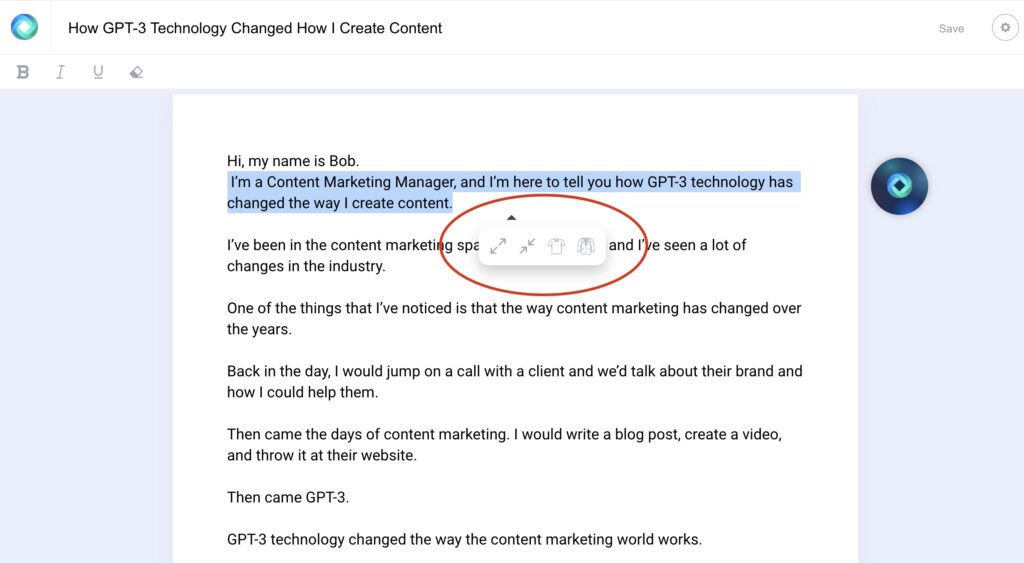
Second, HyperWrite updated its description section. The first description section included a drop-down menu for almost a dozen content options. HyperWrite generated most of the same content, no matter what option writers selected. It now only distinguishes between fiction or non-fiction content, simplifying the description process.

Creating an Article Through HyperWrite
One of the most famous examples of GPT-3 article writing is an article by the Guardian. It caused quite a stir because of the human-like writing of GPT-3 technology. But there were plenty of readers who questioned how much content was written by GPT-3.
I’m not here to pick apart that article – others already did that. Instead, I’m going to write a new GPT-3 article example using our program HyperWrite. I’ll show you exactly how much GPT-3 contributed and what part writers play.
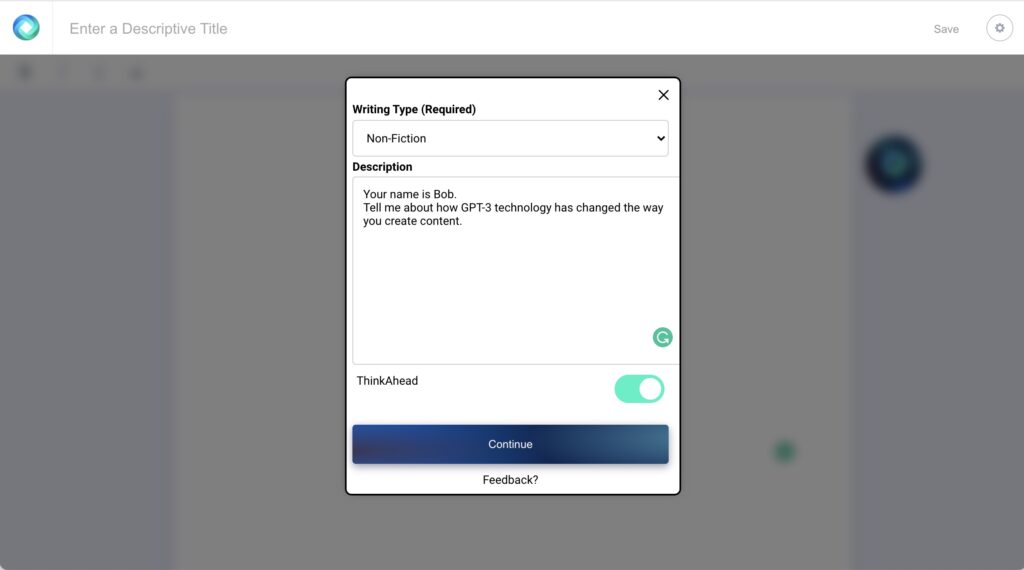
My article will be a testimonial for GPT-3 article writing tools. I gave the HyperWrite tool only a few simple details in the description section because I want this experience to be as hands-off as possible – allowing GPT-3 to be in control.
As I began typing the first sentence, HyperWrite’s ThinkAhead feature immediately kicked in to complete my thought.
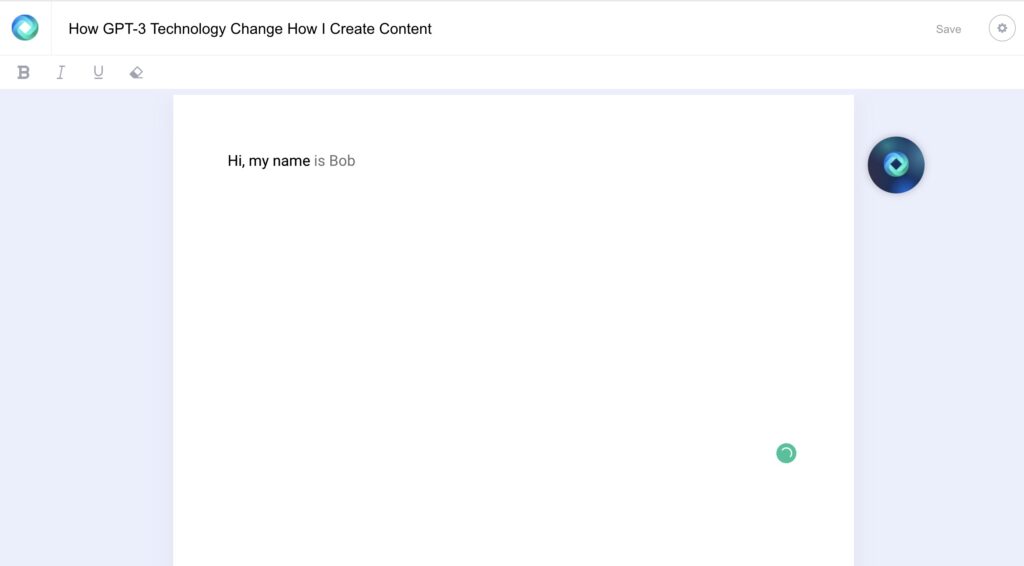
Now that I have the first sentence, my contributions are over. It’s time for HyperWrite to work its magic! HyperWrite’s GPT-3 text generation will exclusively write the rest of the testimonial.
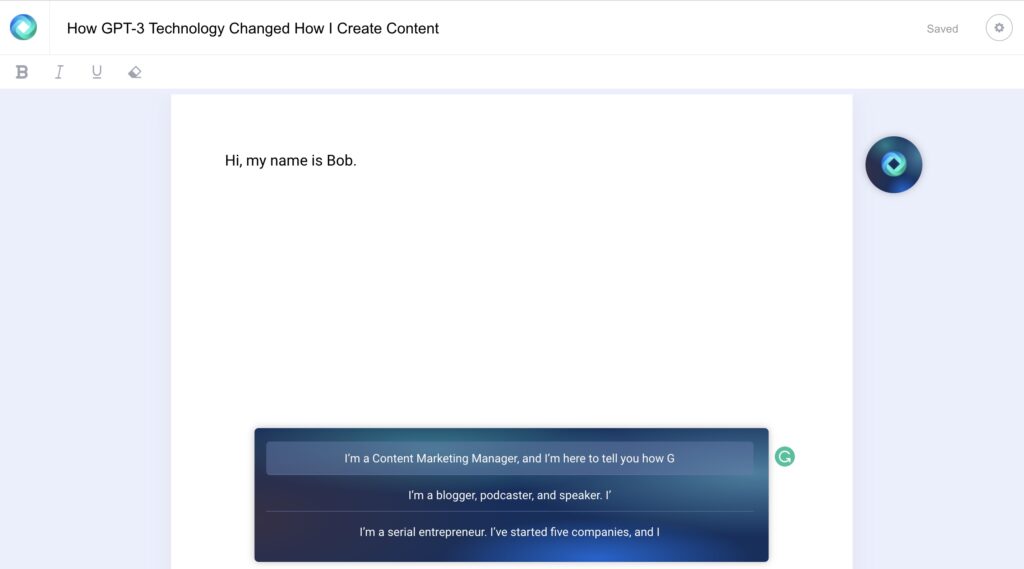
Here’s HyperWrite’s 152-word testimonial from Bob.
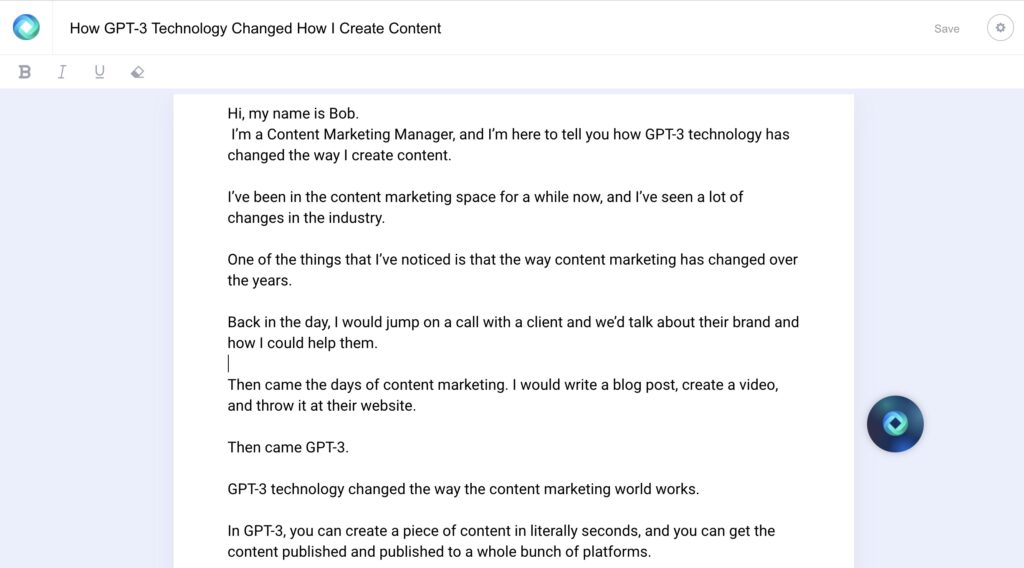
This testimonial is a rough draft I created in less than a minute. It’s a little mundane and has a robotic voice – so it’s far from complete. To finish the testimonial, I’d rearrange the thoughts, add ideas, and give the piece a touch of emotion and human creativity.
After a little human touch, it will be ready to publish!
Change the Way You Create Content with a GPT-3 Article Writer
Are you ready to try out GPT-3 content creation?
You’ll soon find yourself writing content 5-10X faster and saving money. Use the five factors every GPT-3 article writer should have to help you find the best GPT-3 article writer for your team.
At HyperWrite, we’ve already partnered with dozens of expert writers and would love to have you join us too.
You can try out our GPT-3 article writer for free to see if it’s the best fit for your content team.


